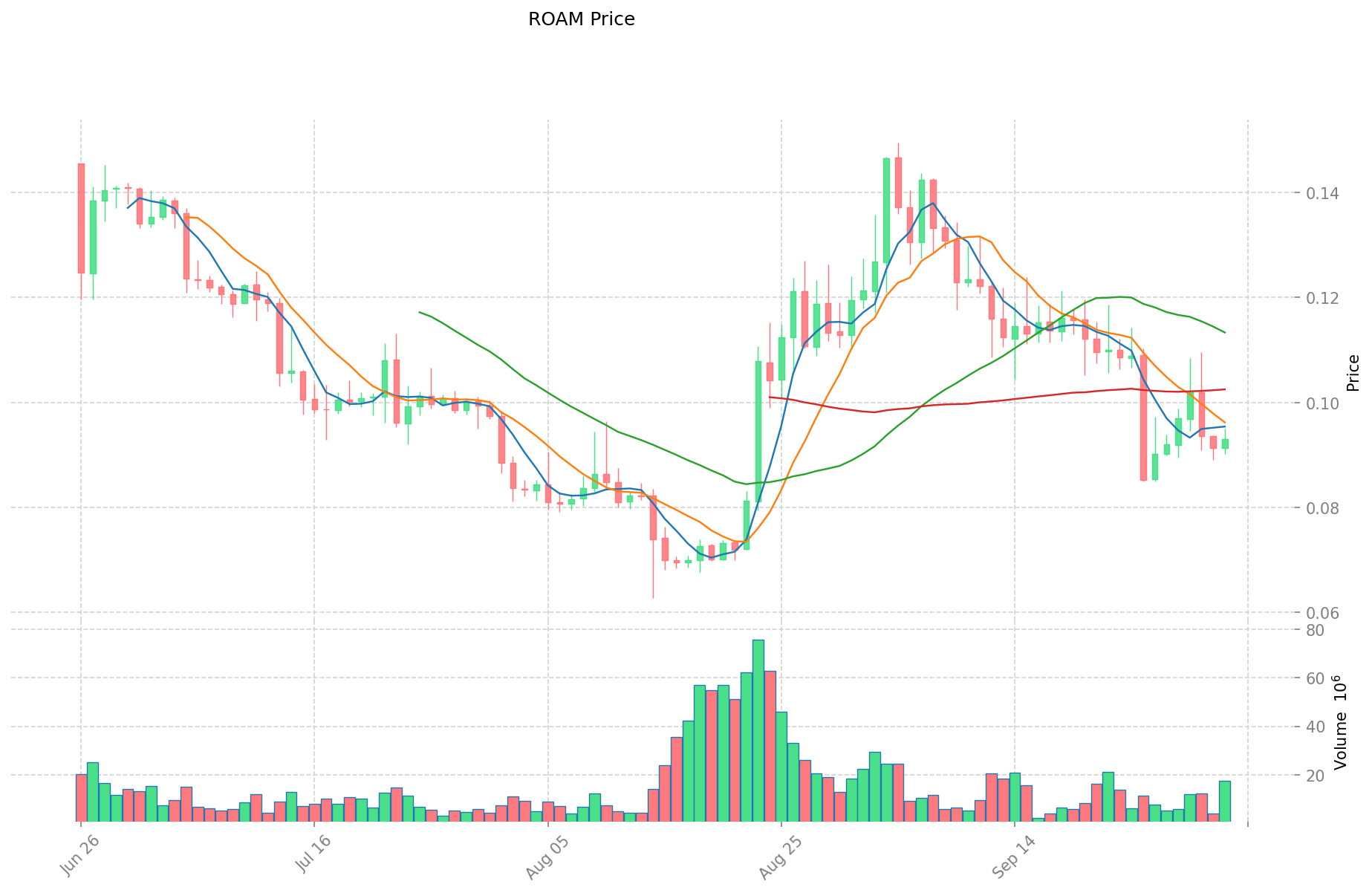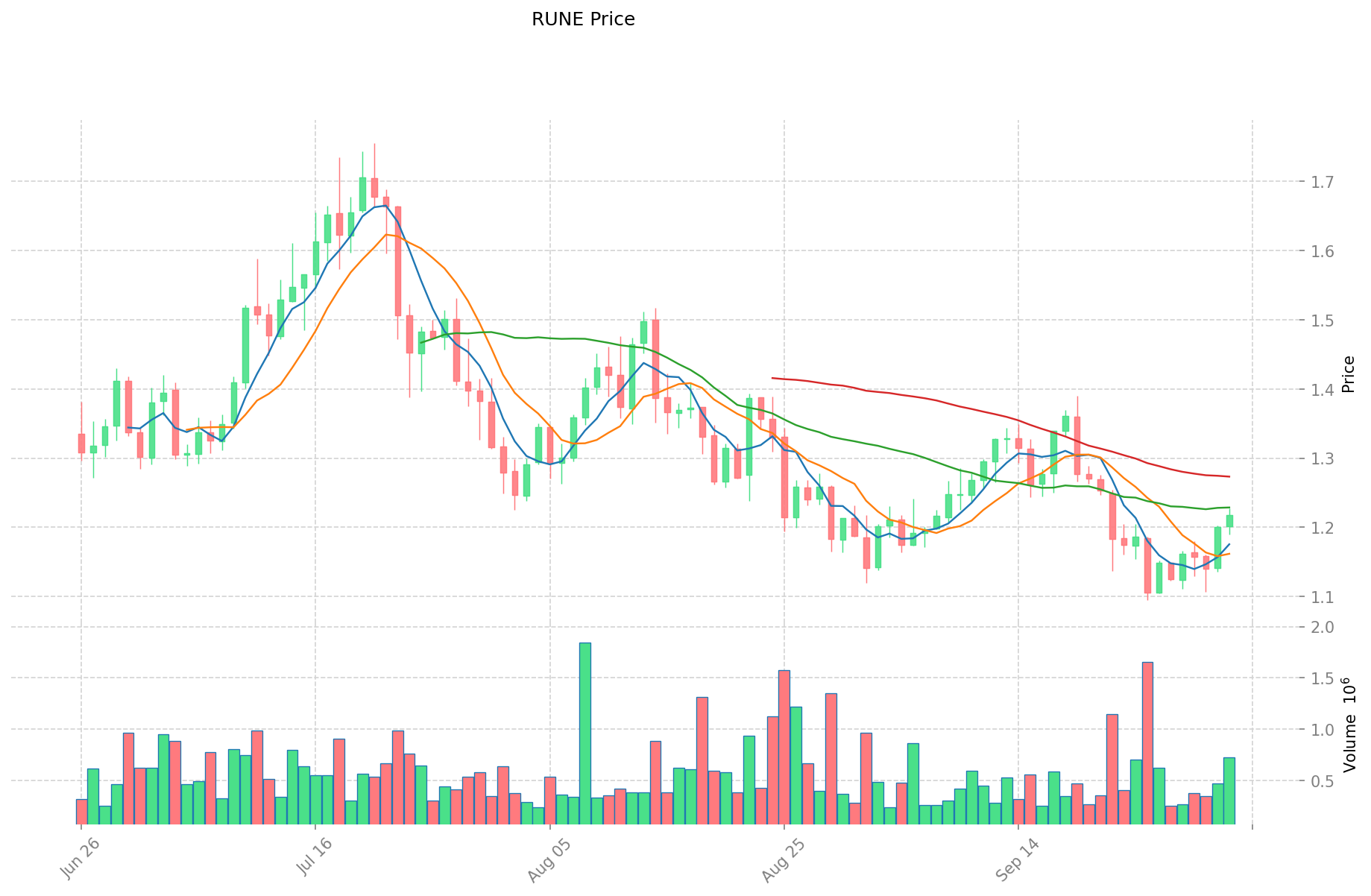ROAM vs RUNE: A Comparative Analysis of Two Emerging Blockchain Technologies in the DeFi Ecosystem
Introduction: Investment Comparison of ROAM vs RUNE
In the cryptocurrency market, the comparison between ROAM vs RUNE has been an unavoidable topic for investors. The two not only have significant differences in market cap ranking, application scenarios, and price performance but also represent different positioning in the crypto asset landscape.
ROAM (ROAM): Since its launch, it has gained market recognition for its position as the largest decentralized wireless network worldwide.
RUNE (RUNE): Since 2019, it has been hailed as a highly optimized multi-chain solution, being one of the cryptocurrencies with high global trading volume and market capitalization.
This article will provide a comprehensive analysis of the investment value comparison between ROAM vs RUNE, focusing on historical price trends, supply mechanisms, institutional adoption, technological ecosystems, and future predictions, attempting to answer the question investors are most concerned about:
"Which is the better buy right now?" Here is the report based on the provided template and data:
I. Price History Comparison and Current Market Status
ROAM (Coin A) and RUNE (Coin B) Historical Price Trends
- 2025: ROAM reached its all-time high of $0.9 on March 6, 2025.
- 2021: RUNE hit its all-time high of $20.87 on May 19, 2021, during the bull market.
- Comparative Analysis: In the recent market cycle, ROAM dropped from its high of $0.9 to a low of $0.05, while RUNE declined from its peak of $20.87 to current levels around $1.2.
Current Market Situation (2025-10-03)
- ROAM current price: $0.08807
- RUNE current price: $1.2007
- 24-hour trading volume: ROAM $1,571,794 vs RUNE $511,735
- Market Sentiment Index (Fear & Greed Index): 64 (Greed)
Click to view real-time prices:
- Check ROAM current price Market Price
- Check RUNE current price Market Price


II. Key Factors Affecting ROAM vs RUNE Investment Value
Supply Mechanism Comparison (Tokenomics)
- ROAM: Limited information available about specific supply mechanisms
- RUNE: Core component of Rune Hero gaming experience with PVP focus
- 📌 Historical Pattern: Supply mechanisms typically drive pricing cycles, though specific data for these tokens is limited.
Institutional Adoption and Market Applications
- Institutional Holdings: ROAM has secured funding in the sub-$10 million range according to 2024 Q3 Web3 investment reports
- Corporate Adoption: Institutional investors are showing renewed interest in crypto assets across financial, gaming, and art sectors
- Regulatory Attitudes: Limited information on specific regulatory approaches toward these tokens
Technical Development and Ecosystem Building
- ROAM Technical Development: Part of emerging Web3 infrastructure projects
- RUNE Technical Development: Focused on gaming applications with Alpha testing requiring invitation codes (approximately 1,400 codes distributed)
- Ecosystem Comparison: RUNE appears to be more gaming-oriented while ROAM seems positioned within broader Web3 infrastructure
Macroeconomic Factors and Market Cycles
- Performance in Inflationary Environments: Investment decisions should consider market changes and adjust strategies accordingly
- Monetary Policy Effects: Market activity, historical performance, and valuation drivers impact price movements
- Geopolitical Factors: Risk management and investment objectives (short-term speculation vs. long-term holding) should guide investment decisions
III. Price Prediction 2025-2030: ROAM vs RUNE
Short-term Prediction (2025)
- ROAM: Conservative $0.075766 - $0.0881 | Optimistic $0.0881 - $0.099553
- RUNE: Conservative $0.623948 - $1.1999 | Optimistic $1.1999 - $1.523873
Mid-term Prediction (2027)
- ROAM may enter a growth phase, with expected price range of $0.0531996255 - $0.1044288945
- RUNE may enter a bullish market, with expected price range of $1.10816704505 - $1.963840333
- Key drivers: Institutional capital inflow, ETF, ecosystem development
Long-term Prediction (2030)
- ROAM: Base scenario $0.108690652462218 - $0.161949072168706 | Optimistic scenario $0.161949072168706+
- RUNE: Base scenario $2.284226855898 - $2.71822995851862 | Optimistic scenario $2.71822995851862+
Disclaimer
ROAM:
| 年份 | 预测最高价 | 预测平均价格 | 预测最低价 | 涨跌幅 |
|---|---|---|---|---|
| 2025 | 0.099553 | 0.0881 | 0.075766 | 0 |
| 2026 | 0.10320915 | 0.0938265 | 0.0750612 | 6 |
| 2027 | 0.1044288945 | 0.098517825 | 0.0531996255 | 11 |
| 2028 | 0.1106059621275 | 0.10147335975 | 0.0821934213975 | 15 |
| 2029 | 0.111341643985687 | 0.10603966093875 | 0.08059014231345 | 20 |
| 2030 | 0.161949072168706 | 0.108690652462218 | 0.093473961117508 | 23 |
RUNE:
| 年份 | 预测最高价 | 预测平均价格 | 预测最低价 | 涨跌幅 |
|---|---|---|---|---|
| 2025 | 1.523873 | 1.1999 | 0.623948 | 0 |
| 2026 | 1.44359969 | 1.3618865 | 1.22569785 | 13 |
| 2027 | 1.963840333 | 1.402743095 | 1.10816704505 | 16 |
| 2028 | 2.1882792282 | 1.683291714 | 1.63279296258 | 40 |
| 2029 | 2.632668240696 | 1.9357854711 | 1.316334120348 | 61 |
| 2030 | 2.71822995851862 | 2.284226855898 | 1.96443509607228 | 90 |
IV. Investment Strategy Comparison: ROAM vs RUNE
Long-term vs Short-term Investment Strategies
- ROAM: Suitable for investors focused on Web3 infrastructure potential
- RUNE: Suitable for investors interested in gaming ecosystems and PVP experiences
Risk Management and Asset Allocation
- Conservative investors: ROAM 30% vs RUNE 70%
- Aggressive investors: ROAM 60% vs RUNE 40%
- Hedging tools: Stablecoin allocation, options, cross-currency portfolios
V. Potential Risk Comparison
Market Risk
- ROAM: Limited market history and potential volatility in emerging Web3 sector
- RUNE: Exposure to gaming industry fluctuations and market sentiment
Technical Risk
- ROAM: Scalability, network stability
- RUNE: Gaming platform security, smart contract vulnerabilities
Regulatory Risk
- Global regulatory policies may impact both tokens differently, with potential scrutiny on Web3 projects and blockchain gaming
VI. Conclusion: Which Is the Better Buy?
📌 Investment Value Summary:
- ROAM advantages: Emerging Web3 infrastructure play, potential for ecosystem growth
- RUNE advantages: Established gaming focus, PVP experience, higher trading volume
✅ Investment Advice:
- New investors: Consider a balanced approach with a slight preference for RUNE due to its more established presence
- Experienced investors: Explore ROAM for potential higher growth in Web3 sector
- Institutional investors: Evaluate both for portfolio diversification, with RUNE for gaming exposure and ROAM for Web3 infrastructure potential
⚠️ Risk Warning: Cryptocurrency markets are highly volatile. This article does not constitute investment advice. None
VII. FAQ
Q1: What are the main differences between ROAM and RUNE? A: ROAM is positioned as part of emerging Web3 infrastructure projects, while RUNE is focused on gaming applications, particularly PVP experiences. ROAM has a more limited market history, while RUNE has been established since 2019 and has a higher trading volume.
Q2: Which token has performed better historically? A: Based on available data, RUNE has shown a more established price history, reaching an all-time high of $20.87 in May 2021. ROAM's all-time high was $0.9 in March 2025. However, both have experienced significant price drops from their peaks.
Q3: What are the key factors affecting the investment value of ROAM and RUNE? A: Key factors include supply mechanisms, institutional adoption, technical development, ecosystem building, and macroeconomic factors such as inflation and monetary policy. ROAM's value is tied to Web3 infrastructure development, while RUNE's is closely linked to the gaming industry.
Q4: How do the future price predictions compare for ROAM and RUNE? A: By 2030, ROAM's base scenario predicts a range of $0.108690652462218 - $0.161949072168706, while RUNE's base scenario predicts $2.284226855898 - $2.71822995851862. RUNE is expected to have a higher percentage increase in price compared to ROAM.
Q5: What are the main risks associated with investing in ROAM and RUNE? A: Both tokens face market risks due to cryptocurrency volatility. ROAM has technical risks related to scalability and network stability, while RUNE faces risks in gaming platform security and smart contract vulnerabilities. Both are subject to regulatory risks, which may impact Web3 projects and blockchain gaming differently.
Q6: How should investors approach allocating between ROAM and RUNE? A: Conservative investors might consider allocating 30% to ROAM and 70% to RUNE, while aggressive investors might opt for 60% ROAM and 40% RUNE. The choice depends on risk tolerance and belief in Web3 infrastructure versus gaming ecosystems.
Q7: Which token is recommended for new investors? A: New investors might consider a balanced approach with a slight preference for RUNE due to its more established presence and higher trading volume. However, individual research and risk assessment are crucial before making any investment decisions.
Share
Content